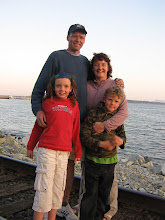The Cabot Trail is a very scenic, mostly coastal, drive around the top of Cape Bretton island and is home to the proud descendants of early Scottish immigrants and Highland Mountains, with road grades of 13%!!! The area is mostly National Park and boasts some fantastic beaches, complete with a hint of pink in the rock and sand and is home to many moose, elk and eagles. The Atlantic is wonderfully warm here and the kids had a great time, body surfing in the big waves.
James loves lobster and is quiet for remarkably long periods of time as he picks his way through, ensuring non is wasted. Our 5th Wheel now has a lobster trap on the roof and a sea star mounted on the skateboard at the back, making us easy to spot and remember. We have encountered many travellers in the campgrounds who, recognising the lobster trap, have mentioned that they have seen us before and remember seeing the lobster trap on the roof.
As this is the turn around point of our trip, we decided to pour out the Pacific water collected on our beach in Comox and collect some Atlantic water to take home.
John Cabot, for whom the trail is named, is thought to have first landed here in the 15th Century. He was an Italian, sailing & exploring for England. Although he was here in the 15th Century, he did not stay and Jacques Cartier is credited with making discoveries much deeper into Canada, when he ventured up the St Lawrence seaway. The French Acadians and the Scots settled Cape Bretton in the late 18th and early 19th Century. For many, it was the first land they saw. Anxious to get off the boat after the, often very difficult, Atlantic crossing they settled here. The scenery would have reminded them of Scotland and they proceeded to name most of it after areas of Scotland. It is said that some seasick wives jumped off the ships and swam to shore, refusing to get back on the ship, once they had found solid ground, forcing their husbands to follow them. Gaelic is still taught here at the Gaelic College in St Annes.















No comments:
Post a Comment